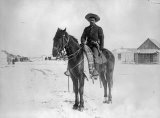
Buffalo Soldiers
The nickname originally applied to the members of the U.S. 10th Cavalry Regiment of the United States Army, which was formed on September 21, 1866 at Fort Leavenworth, Kansas.

The term eventually encompassed these units:
* U.S. 9th Cavalry Regiment
* U.S. 10th Cavalry Regiment
* U.S. 24th Infantry Regiment
* U.S. 25th Infantry Regiment

Although several black regiments were raised during the Civil War to fight alongside the Union Army (including the famous 54th Massachusetts Volunteer Infantry and the many United States Colored Troops Regiments), the "Buffalo Soldiers" were established by Congress as the first peacetime all-black regiments in the regular U.S. Army.
On September 6, 2005, Mark Matthews, who was the oldest living Buffalo Soldier, died at the age of 111. He was buried at Arlington National Cemetery.

Buffalo Soldier History
Buffalo Solider National Museum
Buffalo Solider Monument
Colonel Benjamin Grierson formed the 10th Cavalry on 21 September 1866 at Fort Leavenworth, Kansas. It, along with the 9th Cavalry, 24th and 25th Infantry, formed the first all-black regiments in the Regular United States Army. In western Kansas, the Kiowa encountered the soldiers of the 10th as valiant opponents and termed them the "Buffalo Soldiers." In time, the term designated all of the black soldiers in all four regiments. The Buffalo Solders left Fort Leavenworth to win repeated honors on the plains and in the west. In 1898 the Buffalo Soldiers fought in Cuba winning praise from Theodore Roosevelt and his Rough Riders for their critical role in the battle for Santiago. The Buffalo Soldiers also served on the Mexican border before the American entry into the First World War.

Buffalo Soldier
Bob Marley
Buffalo Soldier, dreadlock rasta
There was a Buffalo Soldier in the heart of America,
Stolen from Africa, brought to America,
Fighting on arrival, fighting for survival.
If you know your history,
Then you would know where you coming from,
Then you wouldn't have to ask me,
Who the 'eck do I think I am.
I'm just a Buffalo Soldier in the heart of America,
Stolen from Africa, brought to America,
Said he was fighting on arrival, fighting for survival;
Said he was a Buffalo Soldier in the war for America.
Dreadie, woy yoy yoy, woy yoy-yoy yoy,
Woy yoy yoy yoy, yoy yoy-yoy yoy!
Buffalo Soldier troddin' through the land, wo-ho-ooh!
Said he wanna ran, then you wanna hand,
Troddin' through the land, yea-hea, yea-ea.
Said he was a Buffalo Soldier win the war for America;
Buffalo Soldier, dreadlock rasta,
Fighting on arrival, fighting for survival;
Driven from the mainland to the heart of the Caribbean.
Dreadie, woy yoy yoy, woy yoy-yoy yoy,
Woy yoy yoy yoy, yoy yoy-yoy yoy!



